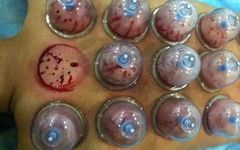
Definition of Bloodletting Therapy
Bloodletting therapy, known as cì luò fàng xuè (刺络放血), is a unique acupuncture treatment method in Traditional Chinese Medicine (TCM). It is one of the most commonly used therapeutic techniques since the era of the Nei Jing (《内经》), which even considers bloodletting as the first choice for treating diseases and alleviating suffering.
According to the patient’s specific condition, a three-edged needle or a thick, sharp needle is used to puncture certain acupuncture points or superficial blood vessels on the patient to release a suitable amount of blood, achieving therapeutic effects.
Effects of Bloodletting Therapy
1
Antipyretic Effect
In TCM, fever is primarily categorized into two types: yang shèng fā rè (阳盛发热) and others. The antipyretic effect of bloodletting is applicable to the former. Since excessive yang energy leads to an abundance of blood, bloodletting can reduce this excess, thereby diminishing the evil heat in the blood vessels and normalizing the body’s qi and blood.
2
Analgesic Effect
TCM holds that “where there is flow, there is no pain; where there is pain, there is blockage.” This means that diseases with pain symptoms must have obstructed areas in their meridians. Bloodletting therapy can directly expel the stagnant pathogenic factors from the meridians, alleviating the blockage, thus relieving pain immediately. Many acute conditions, such as gǎn mào (感冒) and others, have shown rapid improvement with bloodletting therapy.
3
Detoxifying Effect
The detoxifying effect in TCM refers to the body’s inability to resist toxic evils due to pathological conditions, leading to symptoms such as hóng sī dīng (红丝疔) caused by excessive toxic heat. Bloodletting not only expels the invading toxins with the blood but also plays a crucial role in restoring normal bodily functions through the principle of “regulating blood and qi,” thus inhibiting the spread and regeneration of pathogenic factors.
4
Clearing Heat Effect
TCM believes that internal heat disturbances can lead to various diseases, often manifesting as irritability, limb pain and swelling, impatience, and even fever and confusion. Bloodletting therapy can directly expel the heat evil with the blood, making it suitable for various heat syndromes.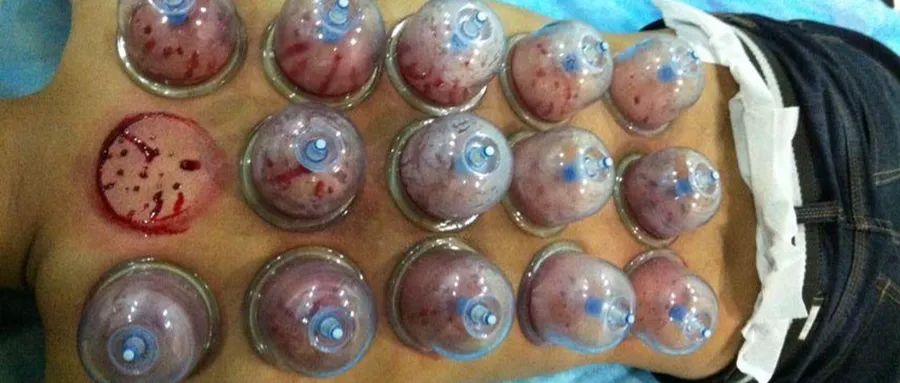
5
Reducing Swelling Effect
Swelling and pain are often caused by qi stagnation and blood stasis, leading to obstruction in the meridians. Bloodletting can directly eliminate the stagnant qi and blood along with the pathogenic factors, promoting unobstructed meridians and achieving the goal of reducing swelling.
6
Anti-Itch Effect
Itching is a manifestation of wind evil present in the blood vessels, hence the treatment principle of “treating wind by first treating blood; when blood flows, wind is eliminated.” Bloodletting regulates blood and qi, ensuring smooth blood flow and eliminating wind evil, thus achieving the effect of relieving itching.
7
Relieving Numbness Effect
Qi deficiency can prevent blood from reaching the extremities, or blood deficiency can fail to nourish, often resulting in numbness. Using fine needles to puncture the affected limb’s acupuncture points to release a small amount of blood is guided by the theory of promoting blood flow to qi, yielding good results.
8
Anti-Nausea Effect
Acute vomiting is often due to excessive heat or liver qi counterflow invading the stomach or food stagnation. Bloodletting can clear heat and pacify liver counterflow, as well as facilitate the downward movement of gastrointestinal stagnation, thus alleviating nausea and vomiting.Methods of Bloodletting Therapy
01
Segmental Bloodletting Method
This method selects acupuncture points for bloodletting based on the location of the disease. For conditions affecting the head, puncture the tai yang (太阳) point; for conditions above the navel, puncture the chǐ zé (尺泽) or qū zé (曲泽) points; for conditions below the navel, puncture the wěi zhōng (委中) point. These points are located near superficial large veins and are suitable for puncturing; the Ling Shu (《灵枢·九针论》) states that the tai yin (太阴), jué yīn (厥阴), and tài yáng (太阳) meridians are all blood-rich meridians. For those with abundant blood, bloodletting is advisable, and the tai yang point is an extraordinary point for treating head and facial diseases effectively, while chǐ zé and wěi zhōng are convergence points primarily for visceral diseases, hence their frequent use.In clinical practice, it is often necessary to combine with other points. This method is mainly used for deeper diseases or visceral conditions, where there are both local primary symptoms and accompanying systemic symptoms.For example, for headaches with red, swollen eyes accompanied by fever, bloodletting at the tai yang point and puncturing hè gǔ (合谷) point; for headaches and sore throat with fever, bloodletting at the tai yang point and puncturing shào shāng (少商) and qū chí (曲池) points; for red, swollen, painful breasts with fever, bloodletting at the chǐ zé point combined with local hot compresses; for upper abdominal pain and vomiting with fever, bloodletting at the chǐ zé point and puncturing zhōng wǎn (中脘) and liáng qiū (梁丘) points; for right lower abdominal pain with constipation and fever, bloodletting at the wěi zhōng point and puncturing zú sān lǐ (足三里) and tiān shū (天枢) points; for lower abdominal pain with purulent blood stools and fever, bloodletting at the wěi zhōng point and puncturing qū chí and tiān shū points, etc.
02
Meridian Bloodletting Method
This method is guided by the theory of “where the meridian passes, the treatment applies” to perform bloodletting along a specific meridian or several meridians affected by disease. In clinical practice, the disease is categorized according to the meridian, and bloodletting is performed along the superficial veins following the meridian’s path. It is also stated that “if it cannot be seen, take it from above and below.”This method is not limited to acupuncture points or painful areas but can also involve puncturing superficial veins along the path of the affected meridian, emphasizing that “it is better to lose the point than to lose the meridian.”For example: for acute low back pain on both sides of the spine, which belongs to the foot tài yáng meridian qi obstruction, puncture the wěi zhōng point and the most painful area of the lower back; for pain along the spine, puncture the rèn zhōng (人中) point and puncture the qì hǎi (气海) and tài chōng (太冲) points; for wind-heat mastitis with sore throat and difficulty breathing, puncture the shào shāng point and puncture the tiān zhù (天柱) point; for vertex headache, dizziness, and eye swelling, puncture the bǎi huì (百会) and tai yang points and puncture the fēng chī (风池) point, etc.
03
Pattern Differentiation Bloodletting Method
This method is guided by the theories of organ differentiation, qi and blood fluid differentiation, and meridian differentiation to select acupuncture points for bloodletting based on the identified patterns.For example: for women with dysmenorrhea and cold pain in the lower abdomen, where pain precedes menstruation, indicating qi stagnation and blood stasis, and obstruction in the foot sān yīn (三阴) meridian, puncture the sān yīn jiāo (三阴交) point for bloodletting, which benefits the liver and kidneys and regulates the menstrual cycle, similar to the effect of si wù tāng (四物汤), puncturing the qì hǎi point to regulate qi, and moxibustion at the guān yuán (关元) point to warm the uterus, collectively achieving the effect of regulating qi and blood; for skin itching and redness, indicating heat in the blood, puncture the sān yīn jiāo and xuè hǎi (血海) points for bloodletting to regulate blood, clear heat, and adjust the menstrual cycle, supplemented by puncturing qū chí to dispel wind and shào fǔ (少府) to clear the heart and eliminate heat; for acute ankle sprains, indicating local qi obstruction and blood stasis, puncture the ā shì (阿是) point and tài chōng point for bloodletting to promote qi and invigorate blood; for carbuncles and boils, based on the principle that “all pain and itching sores belong to the heart,” puncture the qū zé point for bloodletting to drain heat from the heart, and if accompanied by fever, combine with puncturing dà zhuī (大椎) and qū chí points. If the sore appears on the neck and back, combine with puncturing the wěi zhōng point for bloodletting to clear heat from the tài yáng meridian; if it appears on the ribs, combine with puncturing the yáng líng quán (阳陵泉) point for bloodletting to clear heat from the shào yáng meridian; if it appears on the limbs, follow the meridian to select points or puncture the ā shì point for bloodletting to drain meridian heat and detoxify.
04
Local Bloodletting Method
This method involves performing bloodletting at the local site of the disease, either at acupuncture points or in localized areas, and is generally suitable for conditions that are localized and superficial.For example: for swollen and stiff tongue, puncture the jīn jīn (金津) and yù yè (玉液) points for bloodletting; for toothache and gum swelling, perform bloodletting at the affected area and puncture the hè gǔ point; for psoriasis with itching and scaling, use plum blossom needles to prick the local area for bloodletting, combined with cupping; for late-stage filariasis presenting as “rubber leg,” puncture the affected leg from all sides for bloodletting, puncturing the zú sān lǐ and sān yīn jiāo points; for joint sprains and swelling, perform bloodletting at the painful point, etc.
05
Emergency Bloodletting Method
This method is specifically used for emergencies in critical conditions, with four main characteristics:① Located at the extremities or using the twelve jing points; ② At superficial large veins; ③ Using extraordinary points; ④ Selecting points from the governing vessel and pericardium channel. This method provides strong stimulation and rapid effects, facilitating meridian circulation, expelling heat, and awakening consciousness.For example, for syncope with inability to speak, puncture the shí xuān (十宣) points for bloodletting and puncture the rèn zhōng point; for stroke with closed mouth, puncture the tai yang, qū zé, and wěi zhōng points for bloodletting, or the twelve jing points, puncturing yǒng quán (涌泉) and láo gōng (劳宫) points; for snake bites on the upper limb, puncture the qū zé and bā xié (八邪) points for bloodletting; for bites on the lower limb, puncture the sān yīn jiāo and bā fēng (八风) points for bloodletting; for heat stroke, puncture qū zé and shí xuān points for bloodletting, puncturing yǒng quán etc.
Corresponding Acupuncture Points for Different Symptoms
Brain Hemorrhage (Stroke)
For any bleeding, there must be coma, thus puncture the yìn táng (印堂), tai yang, tài chōng, and shí zhǐ (十指) points to release 1-5 drops of blood, which can promote early awakening and reduce the degree of hemiplegia. Remember: if a patient is in a coma for more than 24 hours, the rate of hemiplegia is over 90%. If it exceeds 72 hours, there is a 100% chance of hemiplegic sequelae. Therefore, promoting early awakening of the patient is a priceless secret; once the patient awakens, puncture the dà zhuī, qū chí, wěi zhōng points for bloodletting, and the patient may have a chance of recovery.
Neuralgia
If it belongs to gallbladder meridian pain (outer thigh pain), carefully examine the yáng líng quán and fēng lóng (丰隆) points for any obstructed blood vessels; if present, bloodletting may lead to recovery.
Long-lasting Boils and Carbuncles
Puncture the heart point after bloodletting.
Initial Stage of Conjunctivitis, Stye Not Yet Pus-filled
Puncture the tai yang point for bloodletting, squeezing out 7-9 drops of blood, and squeezing 3-5 drops from the middle toe of both feet can lead to recovery by the next day.
Rheumatism
Puncture 3 inches beside the third, fourth, and fifth thoracic vertebrae for bloodletting, which can yield significant effects; many severe cases can be cured in 1-2 sessions.
Gastric and Duodenal Ulcers
Puncture the blue veins from the inner ankle to the jiě xī (解溪) point, and near the outer ankle for bloodletting. For gastric ulcers, look for blood vessels within 0.5 inches above and 2.5 inches below the tiáo kǒu (条口) point.
Chronic Nephritis
(1) Puncture the rú yú (儒俞) point for bloodletting if there is yellow fluid; once the yellow fluid is gone, the patient recovers. (2) Around the kidneys. (3) Puncture around the navel (do not puncture the center of the navel).
Hepatitis Bloodletting
Puncture the yáng jiāo, zú sān lǐ, qū zé, yáng líng quán, and sān yīn jiāo points.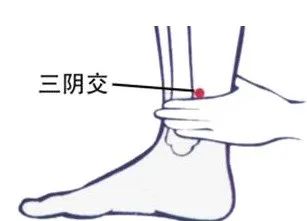
Ascites Due to Cirrhosis
Use the acupuncture points for hepatitis plus: shèn yú (肾俞), yāo yú (腰俞), and tiáo kǒu (条口) points (0.5 inches above and 0.5 inches outside), and gān yú (肝俞).
Effective Points for Hemorrhoids
(1) chāo jiāo (龊交) point (inside the mouth), find the white grain point; 1-3 sessions can lead to recovery. (2) For red, swollen, and ulcerated anal areas, puncture the wěi zhōng point, which will reduce pain immediately.
Insomnia
(1) shénmén (神门), xíng jiān (行间), zú sān lǐ points. (2) Puncture dà zhuī, shén dào (神道), zhōng wǎn points, and then apply cupping.
Cervical Spondylosis
Painful points, tiān zōng (天宗), jiān zhēn (肩贞), and chǐ zé points.
Chest Internal Injury
Puncture dà zhuī, jiān jǐng (肩井), and then the injured area.
Shoulder Periarthritis
Puncture the shèn guān (肾关) point (1.5 inches below yáng líng quán) and chǐ zé point; one session can yield results.
Acute and Chronic Throat Diseases
Puncture dà zhuī, ěr jiān (耳尖), ěr bèi jīng (耳背静脉), shào shāng, qū chí, tai yang points; bloodletting will reduce pain.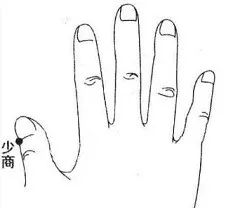
Impotence
(1) Puncture the shèn yú, fù liú (复溜) points for bloodletting, guān yuán, and apply cupping at the shèn yú point for 15 minutes. (2) Puncture the sān yīn jiāo, mìngmén (命门), and apply cupping at the shèn yú and xuè hǎi points.
Hypertension
Puncture the tai yang, dà zhuī, ěr jiān, qū chí points; bloodletting will lower blood pressure immediately. Note: Do not drink water within one hour after bloodletting, or the effect will be diminished.
Asthma
Puncture the dà zhuī, fèi yú (肺俞), fēngmén (风门), gāo máng, and liè quē points for bloodletting. Apply cupping at zhōng fǔ and dà zhuī points for 15 minutes.
Hyperlipidemia
Puncture the dà zhuī, tai yang, yāo yú, wěi zhōng, and qū chí points.
Rheumatic Heart Disease
Puncture the yáng jiāo, chǐ zé, and tai yang points.
Otitis Media
Puncture the outer ankle joint for bloodletting.
Epilepsy
(1) Puncture the tai yang, qū zé, wěi zhōng, and yáng jiāo points. (2) Puncture the shào shāng and rèn zhōng points for bloodletting. Apply cupping at the gān yú and dà zhuī points for 15 minutes. (3) Locate painful points at the lower back of the neck and the nèi guān (内关) point, using plum blossom needles to prick for bloodletting.
Mental Illness
Puncture the tai yang, qū zé, wěi zhōng, shù chōng (术冲), yáng jiāo, fēng lóng, and xīn yú (心俞) points; apply cupping after bloodletting.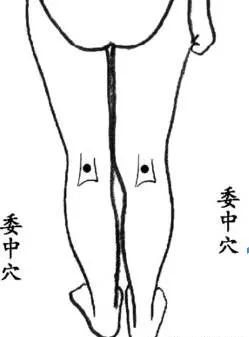 For diseases that have not responded to treatment, when all methods have failed, one should puncture the blood vessels at the ankles, elbows, wrists, and knees to achieve unexpected effects.Note: Bloodletting should generally not be performed at night; it is best done in the early afternoon. This method is not suitable for individuals with weak constitutions, pregnant women, or those with poor coagulation mechanisms. It is particularly emphasized that the technique should be steady, precise, and gentle, rather than forceful, and bloodletting should not be excessive. This should be performed under professional guidance!
For diseases that have not responded to treatment, when all methods have failed, one should puncture the blood vessels at the ankles, elbows, wrists, and knees to achieve unexpected effects.Note: Bloodletting should generally not be performed at night; it is best done in the early afternoon. This method is not suitable for individuals with weak constitutions, pregnant women, or those with poor coagulation mechanisms. It is particularly emphasized that the technique should be steady, precise, and gentle, rather than forceful, and bloodletting should not be excessive. This should be performed under professional guidance!
If you like this, please like  + look at this
+ look at this 
Let more people see this ▼

